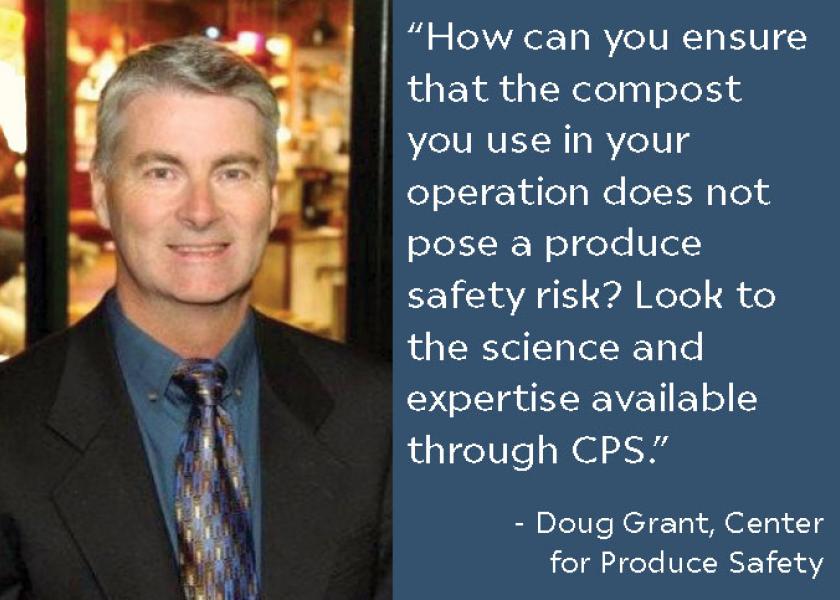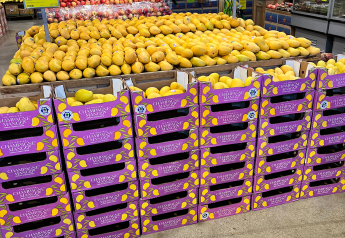Food safety focus: Turning up the heat on composting

Sometimes we need to take a step back from life’s challenges and marvel at Earth’s natural biological cycles happening all around us. Composting is a seemingly magical process that decomposes organic materials like green waste or animal manures through microbial fermentation, creating nutrient-rich amendments that can be added back to soils. Both conventional and organic farming employ finished compost to enhance tilth and provide slow-release fertilizer for crops.
However, compost can also pose a risk to the food safety of fresh produce.
Animal manure is widely suspected to be a significant source of human pathogens. Cows can carry E. coli, while poultry and swine can carry Salmonella. If compost is made with manure containing such pathogens, and the composting process is not controlled properly, these pathogens can survive composting. Contaminated compost applied to fields can then cross-contaminate fresh produce that contacts amended soil during growth, irrigation or harvest.
How can you ensure that the compost you use in your operation does not pose a produce safety risk? Look to the science and expertise available through the Center for Produce Safety (CPS).
Gurmail Mudahar, Ph.D., is vice president of research and development and food safety at Tanimura & Antle and is a member of CPS’s technical committee and California Leafy Greens Marketing Agreement’s (LGMA) advisory board. He reports that his company used to prepare and apply their own animal manure-based composts. That changed when food safety emerged as a major leafy greens industry issue almost two decades ago.
Then Tanimura & Antle and other growers began buying compost only from specialized manufacturers to minimize produce safety hazards.
More food safety insight from CPS: A good marketing offense starts with food safety defense
At its simplest, composting is a manufacuring process. To produce compost safely, the most critical controls are high temperature and time held at that temperature. Over time, the heat generated by microbial respiration in turn reduces the compost’s microbial population, including any human pathogens present.
As a general rule, compost temperatures must reach 131 degrees Fahrenheit or 55 degrees Celsius for 3-15 days, followed by a curing phase of least 21 days and preferably a few months. (Once applied to agricultural fields, pathogens continue to die off when exposed to sunlight’s ultraviolet rays, humidity, temperature, time and other factors.)
Each composting method – such as vessel containment, windrowing or aereated static piles – has other unique variables to control for safety. Those include the type of organic material used, microbiota present, initial pathogen load, moisture, ammonia generation aeration and turning regime.
Compost safety is covered in more detail by several sources, including federal (40 CFR §503) and state regulations (e.g., California’s Title 14), as well as the U.S. Compost Council Seal of Testing Assurance program and the National Organic Program’s Compost Guidance. Some marketing agreements mandate adherence, such as the food safety-focused California and Arizona LGMAs.
Mudahar notes that Tanimura & Antle’s compost sourcing best practices include:
- Compost must be prepared according to state, federal and LGMA standards.
- Suppliers must document they have complied with composting processes, and that the compost is pathogen-free.
- Compost is applied only when needed, typically every 2-4 years, as most farms also till back into the soil organic material that is left over from harvest.
- Compost is applied off-season, at least two months before planting to allow any remaining pathogens to die off.
It must also be noted that on-farm composting operations can pose risks to neighboring fields.
Cross-contamination can occur many ways, including from stored inputs and in-process compost piles, or when compost is aerosolized during field application. Pathogens can then also contaminate surface and ground water.
It is often difficult to find the root cause of a produce-related foodborne illness outbreak for many reasons, and use of improperly-prepared compost has rarely been implicated. So should we be concerned about compost and produce safety? According to several CPS-funded studies, the answer is yes.
Clemson University’s Xiuping Jiang, Ph.D., and team showed that human pathogens can persist if proper composting procedures aren’t followed. (Interestingly, they also found that innoculating beneficial microbiota back into compost can minimize human pathogens.) USDA’s Manan Sharma, Ph.D., and colleagues found some commercial composts contained human pathogens. And a team led by Keith Warriner, Ph.D., at Canada’s University of Guelph showed that some human pathogens can persist in the field for more than 120 days, depending on soil type and other conditions.
Compost can be a great production asset; it shouldn’t become a fresh produce liability. Managing compost is extremely important to minimize the presence of human pathogens in fresh produce fields to safeguard the foods grown there.
Follow the latest science and relevant guidance when buying compost and for making and applying your own compost. Be aware that actively composting in close proximity to produce production can pose a significant cross-contamination hazard, and the risk must be managed very carefully or avoided altogether.
Keep the heat in the composting process – not on your business.
Doug Grant chairs Center for Produce Safety’s Knowledge Transfer Task Force and is a CPS board member. He is executive vice president and COO of The Oppenheimer Group.







